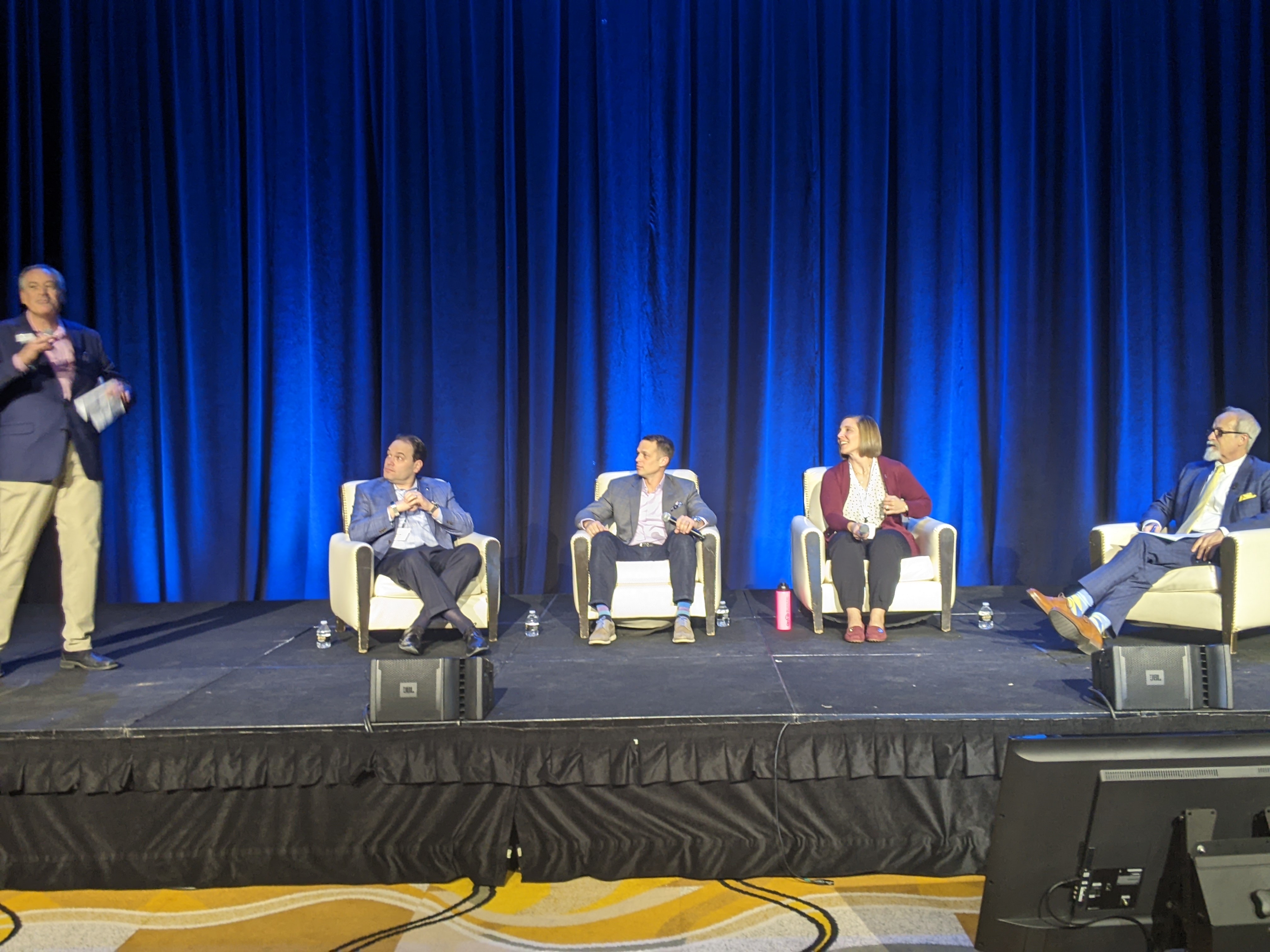In Case You Missed It: CUES 2023 Future & Economic Summit was All about Culture
The CUES 2023 Future & Economic Summit returned this year for the first time since February 2020. CUES prides the event on being a dynamic credit union conference created to provide professional development on a broad scope of topics for current and emerging industry leaders.
This year’s Future & Economic Summit focused on what’s in store for our economy’s near future, artificial intelligence uses, mergers and acquisitions and many other topics. However, one topic seemed to keep coming back up: culture.
What is culture? How is it shaped? Who shapes it? How is it maintained? How does it affect business?
These were some of the many questions discussed during the CUES 2023 Future & Economic Summit.
Cohesion Culture with Dr. Troy Hall
To start the conversation around culture, Dr. Troy Hall, a talent retention expert, gave a keynote around the idea of cohesive culture and retaining top talent.
“Workplace cohesion is an opportunity to level up the credit union’s model of ‘people first. Financial services second.’ model,” he said.
Focus on the employee first, then the member. When you do that, he said, you have a whole team focused on the same thing: the member.
Hall said too often culture becomes a tactic, not a strategy. It’s filled with tactical items we need to do, but we haven’t elevated it to the point that it becomes a strategy. And in order to successfully integrate culture into strategy, he said executives need to elevate the employee voice to the senior level.
“If the voice of the workplace culture isn’t represented during executive meetings, then the only focus will be other strategies,” continued Hall.
The speaker talked about how our current economy, considering the unemployment rate, is employee-driven. So, he asked, what do we do to retain talent?
We can offer all sorts of things, like increases and finding a way to woo them. But workplace cohesion, Hall suggests, is a better advantage. And then, place a strategic framework over your culture in order to keep it intact.
Important to many credit unions, Hall added that the smaller your organization, the more your workplace culture reveals itself. In larger organizations, there are so many subcultures that grow in the many different departments.
Speaking on workforce trends, particularly remote work, the speaker talked about the conversation around culture in a remote environment, “Culture belongs to everyone, whether they’re under the same roof or not. You may not have the culture you’re comfortable with, but you have a culture.”
According to presented data, 36 million employees will work remotely in 2025, suggesting leaders will have to find a way to create a culture they are comfortable with in remote environments sooner or later.
Hall also talked about the primary things workers want from an organization right now, including a more selective work environment, flexible work hours and locations and autonomy and initiative.
Another big one was growth and development. Hall said 71% of employees are interested in growth and development opportunities. This doesn’t mean being a CEO one day, but it’s about growing with the team, developing skills and being a real part of an organization’s future.
And when onboarding, he said, tell them what the future is. And make sure you’re teaching the culture as much as office logistics. Yes, they need to know where the printer is and how the computer works, but don’t overlook teaching cultural expectations.
These things are important to talent retention, and talent retention is important to retaining a cohesive culture, just as it is important to an organization’s bottom line. The cost of replacing a team member cost more than 50% of that salary.
“It might not show up as a significant line item but it’s found in lost organizational knowledge and overall opportunity cost when that team member leaves,” said Hall.
He ended his keynote with one important message: “Culture is built on how you treat people, not the treats you give them.”
CEO Panel: Carrie Iafrate, Brad Bergmooser, Ryan Goldberg
 Later in the day, a panel of Michigan credit union CEOs took the stage, moderated by Dr. Hall. The panel consisted of Carrie Iafrate (Members First Credit Union), Brad Bergmooser (Financial Plus Credit Union) and Ryan Goldberg (DFCU).
Later in the day, a panel of Michigan credit union CEOs took the stage, moderated by Dr. Hall. The panel consisted of Carrie Iafrate (Members First Credit Union), Brad Bergmooser (Financial Plus Credit Union) and Ryan Goldberg (DFCU).
Before discussing culture, they talked about mergers and acquisitions in the current landscape — both integrating and being integrated into a larger organization.
Mergers
“Merging should definitely be a discussion you have during discussions about growth, and whether it’s the right decision or the wrong decision for your organization,” said Bergmooser. “If you're not part of the discussion, you're being left out. Growth for growth’s sake shouldn’t be part of the equation. It should always be about scale, and wanting to be the best credit union for your members.”
Goldberg was able to speak on the topic using a recent DFCU acquisition in Florida as examples of what to do, what not to do and ways that these transactions can help credit unions find underserved members.
In particular, he said part of the decision to make an acquisition was to take DFCU’s member focus to an organization in Florida that wasn’t focused on the consumer, in order to bring their products and services to more consumers.
When asked about ongoing debates about whether small credit unions should stay the fight or welcome being merged, Iafrate said it all comes down to the board, their members and their growth strategy. Bergmooser echoed her sentiments, that whether a credit union should merge is not up to anybody but the credit union and their board, who should be basing their decisions on what’s good for the member, suggesting that it’s not up for a larger debate.
“As an industry,” added Bergmooser, “we need to provide an environment for small credit unions to exist.”
Bergmooser also spoke on the importance of being cognizant and respecting the culture and history within the organization on the merging side. The integration is filled with people who have built something together and being empathetic is important.
Adding onto that, Goldberg said you cannot communicate enough while in the process of an acquisition or merger. Sometimes, he said, if people have been through mergers or acquisitions in the past, they may have different expectations and the best way to counter that is to keep communicating.
Culture
Hall then asked the panel how the CEOs have made culture a priority.
“Culture is my main job,” said Iafrate. “I have to invest every single day in what I’m doing, so that it continues throughout my 240 team members.”
Iafrate said she has a personal brand statement that incorporates within her company’s brand statement, and it’s built on intentional leadership
“It cannot just be words,” she continued. “You have to help that team understand that they matter and that their work is important.”
She also advised other leaders to not only give teams surveys, but communicate it back to them, use it as a way to build a conversation.
Speaking as an incoming CEO, Goldberg said, regarding culture, he made sure his intentions were clear. He wanted to alleviate concerns that he was coming in to change everything.
“It was really my job to come in and integrate into the culture,” said Goldberg.
Bergmooser said he puts the question of culture back on the employees, “I don’t get to sit in my ivory tower and say ‘boom, this is the culture.’ The result of how we treat each other is our culture. You owe it to yourself to create a culture that you want to work in everyday.”
Of course, he said you have to hire according to cultural fits, and he looks for good energy fits for Financial Plus’ culture.
Compensation
On compensation, Bergmooser said we need to separate culture and pay, “Objectify pay. You have to pay for talent.”
For DFCU, Goldberg said it’s important to be competitive in pay, “People have to feel like they’re being treated fairly.”
“Credit unions are becoming more complex and asking team members to do more, and so we need to be commensurate in order to step up our game as a credit union,” continued Goldberg.
He also spoke about the importance of creating transparency and a dialogue, as well as coming to team members with raises and incentives first so that the trust isn't being broken when and if there is a battle over negotiations.
Iafrate closed the panel by saying Members First has recently replaced its highly incentivized culture with a higher compensation pay base and has had incredible success with it.
« Return to "MCUL Newsroom"

